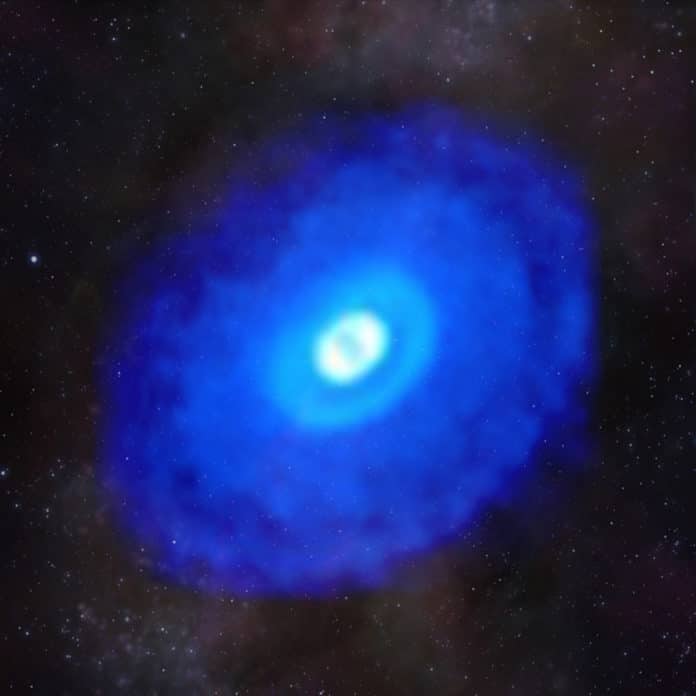The protoplanetary disks surrounding the stars contain molecules that may impact planets, like how and where planetary formation occurs, the chemical composition of the planets, and whether those planets have the organic composition necessary to support life.
Recently, by using Atacama Large Millimeter/submillimeter Array (ALMA), an international collaboration of scientists has completed the most extensive chemical composition mapping of the protoplanetary disks around five nearby young stars. The mapping generated high-resolution images that capture the molecular composition associated with planetary births.
The results of the program, appropriately called MAPS, or Molecules with ALMA at Planet-forming Scales.
MAPS, in particular, focused on protoplanetary disks around five stars named IM Lup, GM Aur, AS 209, HD 163296, and MWC 480. The study also highlights the link between dust and chemical substructures and large reservoirs of organic molecules in the inner disk regions of the stars.
Karin Öberg, an astronomer at the Center for Astrophysics, said, “With ALMA, we were able to see how molecules are distributed where exoplanets are currently assembling. One of the fascinating things we saw is that the planet-forming disks around these five young stars are factories of a special class of organic molecules, so-called nitriles, which are implicated in the origins of life here on Earth.”
The team observed simple organic molecules like HCN, C2H, and H2CO in the inner regions of the disks in unprecedented detail.
Viviana V. Guzmán, an astronomer at Pontificia Universidad Católica de Chile’s Instituto de Astrofísica, said, “We’re finding that our Solar System is not particularly unique and that other planetary systems around other stars have enough of the basic ingredients to form the building blocks of life.”
Other more organic molecules were also observed. Those molecules were HC3N, CH3CN, and c-C3H2—notably those containing carbon. This is not the first time such molecules are being detected in protoplanetary discs; however, MAPS is the first systematic study across multiple disks at very high spatial resolution and sensitivity.
John Ilee, an astronomer at the University of Leeds and the lead author of MAPS IX, said, “We found more of the large organic molecules than expected, a factor of 10 to 100 more, located in the inner disks on scales of the Solar System, and their chemistry appears similar to that of Solar System comets. The presence of these large organic molecules is significant because they are the stepping-stones between simpler carbon-based molecules such as carbon monoxide, which is found in abundance in space, and the more complex molecules that are required to create and sustain life.”
MAPS III and IV revealed that while the general disk compositions appear to be similar to the Solar System, zooming in at high resolution reveals some diversity in composition that could result in planet-to-planet differences.
Charles Law, CfA astronomer and lead author on MAPS III and IV, said, “Molecular gas in protoplanetary disks is often found in sets of distinct rings and gaps. But the same disk observed in different molecular emission lines often looks completely different, with each disk having multiple molecular faces. This also means that planets in different disks or even in the same disk at different locations may form in radically different chemical environments. This means that some planets form with the necessary tools for building and sustaining life while other nearby planets may not.”
Arthur Bosman, an astronomer at the University of Michigan and lead author of MAPS VII, said, “One of those radically different environments occurs in the space surrounding Jupiter-like planets, where scientists found the gas to be poor in carbon, oxygen, and heavier elements, while rich in hydrocarbons, such as methane. The chemistry that is seen in protoplanetary disks should be inherited by forming planets. Our findings suggest that many gas giants may form with extremely oxygen-poor (carbon-rich) atmospheres, challenging current expectations of planet compositions.”
Joe Pesce, astronomer and ALMA program officer at the National Science Foundation (NSF), notes, “Whether life exists beyond Earth is one of humanity’s fundamental questions. We now know planets are found everywhere, and the next step is to determine if they have the conditions necessary for life as we know it (and how common that situation might be). The MAPS program will help us better answer these questions. ALMA’s search for precursors to life far from Earth complements studies conducted in laboratories and places like hydrothermal vents on Earth.”
Öberg added, “MAPS is the culmination of decades of work on the chemistry of planet-forming disks by scientists using ALMA and its precursors. Although MAPS has surveyed just five disks at this time, we had no idea how chemically complex and visually stunning these disks were until now. MAPS has first answered questions we could not have imagined asking decades ago and also presented us with many more questions to answer.”
Journal Reference:
- Molecules with ALMA at Planet-forming Scales (MAPS) I: Program overview and highlights, K. Öberg et al., ApJS, preview [https://arxiv.org/pdf/2109.06268.pdf]
- Molecules with ALMA at Planet-forming Scales (MAPS) III: Characteristics of radial chemical substructures, C. Law et al., ApJS, preview [https://arxiv.org/pdf/2109.06210.pdf]
- Molecules with ALMA at Planet-forming Scales (MAPS). IV: Emission Surfaces and Vertical Distribution of Molecules, C. Law, ApJS, preview [https://arxiv.org/pdf/2109.06217.pdf]
- Molecules with ALMA at Planet-forming Scales (MAPS) VI: Distribution of the small organics HCN, C2H, and H2CO, V. Guzmán et al., ApJS, preview [https://arxiv.org/pdf/2109.06391.pdf]
- Molecules with ALMA at Planet-forming Scales (MAPS) VII: Substellar O/H and C/H and superstellar C/O in planet-feeding gas, A. Bosman et al., ApJS, preview [https://arxiv.org/pdf/2109.06221.pdf]
- Molecules with ALMA at Planet-forming Scales (MAPS) IX: “Distribution and properties of the large organic molecules HC3N, CH3CN, and c-C3H2,” J. Ilee et al., ApJS, preview [https://arxiv.org/pdf/2109.06319.pdf]
